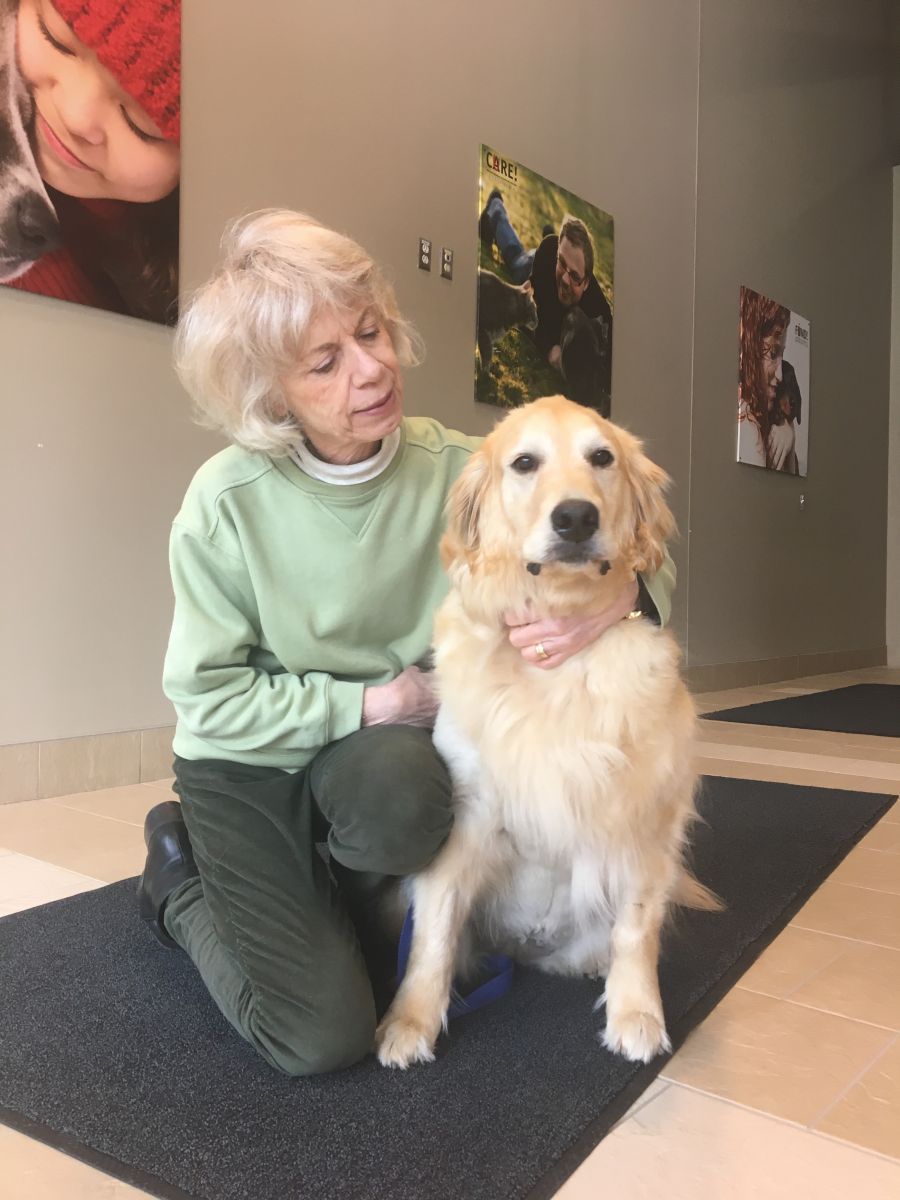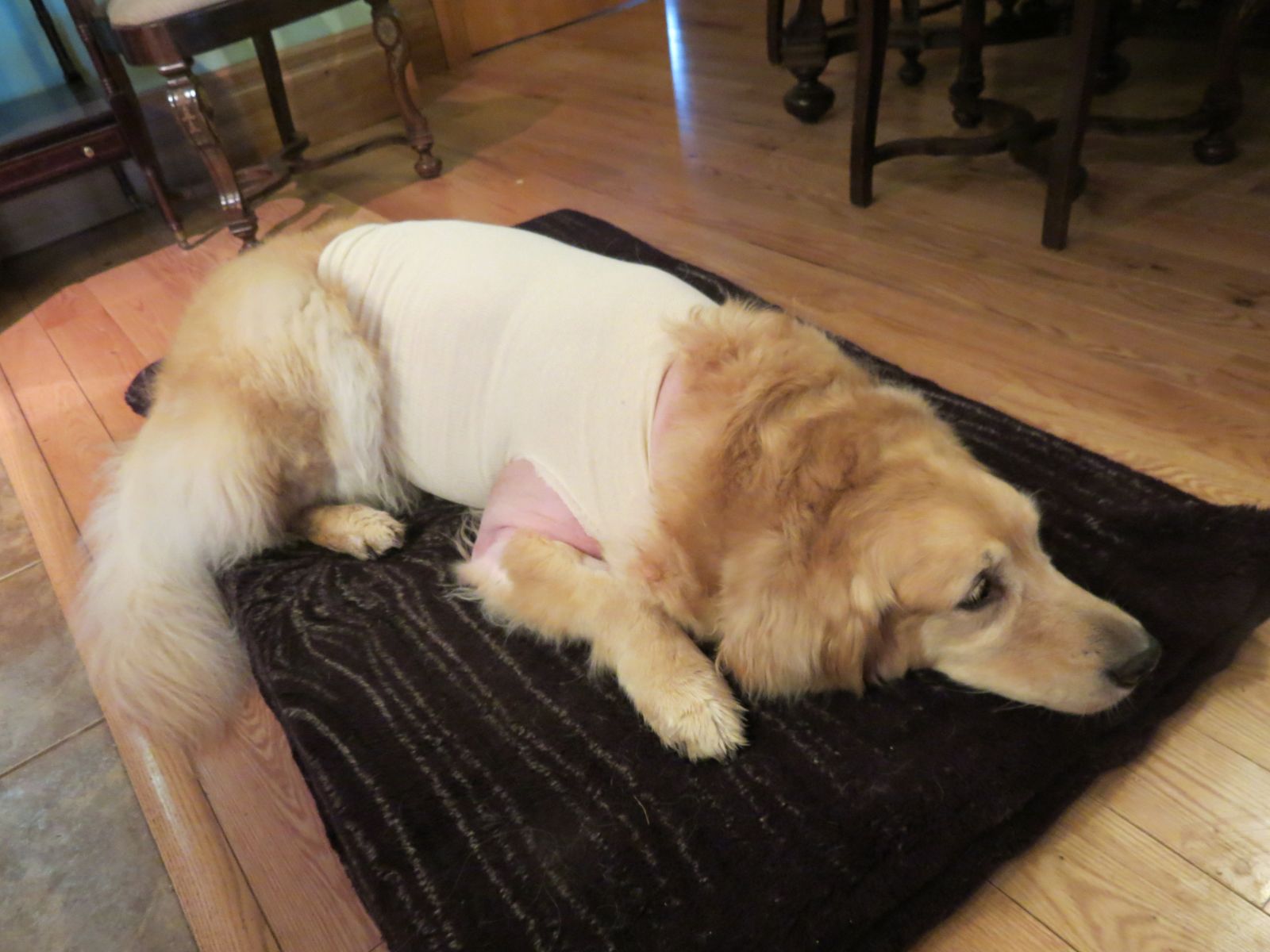By Nancy Silcox
 “Hailey has a type of cancer called hemangiosarcoma that’s growing on her heart,” stated Dr. Brigitte Brisson, a veterinary surgeon at the OVC Companion Animal Hospital. “It’s an aggressive, malignant tumour originating in the blood vessel cells,” she continued, “and it’s serious.” The words made my knees buckle.
“Hailey has a type of cancer called hemangiosarcoma that’s growing on her heart,” stated Dr. Brigitte Brisson, a veterinary surgeon at the OVC Companion Animal Hospital. “It’s an aggressive, malignant tumour originating in the blood vessel cells,” she continued, “and it’s serious.” The words made my knees buckle.
Guardians of Golden Retrievers for much of our married life, my husband Louis and I were fully aware the breed’s reputation as being prone to developing cancer. Indeed, over the years, we had lost all of our Goldens to one form or the other of the dreaded cancer.
“But she’s so young, she only just turned seven,” I questioned. “How can this be happening? Our other Goldens lived into their teens.”
Dr. Brisson’s response brought me little comfort. “Golden Retrievers are unfortunately at the top of the list for breeds that may develop hemangiosarcoma. We’ve treated some even younger than Hailey.”
And so our journey through canine cancer began.
xxxxx
Two weeks earlier, the illness had come on suddenly. One day her usual “Golden” self—alert, active and seemingly always up for eating, the next day Hailey was quite a different dog – lethargic, refusing food, but with an increase in her appetite for water, as well as a seeming need to cool her body by rolling in snow. After two days, we headed to our local veterinary clinic.
A listen to Hailey’s heart told OVC graduate Dr. Anne Marie Hunter of the New Hamburg Veterinary Clinic that the “wait and see” approach was not an option. When diagnostic tests confirmed fluid around the heart, Dr. Hunter advised that we head for OVC immediately. “Given the breed, and Goldens’ high incidence of hemangiosarcoma, it was crucial that Hailey receive treatment immediately,” she later said.
And so, with Dr. Hunter coordinating with staff at the OVC Companion Animal Hospital, we were on our way, with x-rays in hand. Long considered a centre for excellence in veterinary medicine, the OVC Health Sciences Centre treats more than 5,000 companion animals each year—many through veterinary referral.
Upon arrival, Hailey was immediately taken in for examination. Confirming Dr. Hunter’s suspicions that the mass showing in Hailey’s x-rays was most likely hemangiosarcoma, receiving veterinarian Dr. Greta Vandeventer suggested that she remain under observation over the weekend. Over that period of time, with a multitude of tests, a determination would be made whether surgery to remove the mass was an option, if that was our choice.
It was an anxious weekend without our pet, but twice daily telephone calls kept us up-to-date on her condition. Fourth year Doctor of Veterinary Medicine student Chanel was our “points person” and she unabashedly admitted that she had fallen in love with our girl.
Clearly regular communication between this veterinary hospital and home was a given.
xxxxx
Further tests on Hailey had confirmed the diagnosis of hemangiosarcoma and OVC medical staff shared the reality of the disease. A malignant cancer, originating in the blood vessels of the canine body, it settles, in most cases in the  spleen, but also in the liver or under the skin. Its presence in Hailey’s heart (right atrium) was more uncommon, but no less deadly. No matter the organ, hemangiosarcoma moves on to metastasize in other organs.
spleen, but also in the liver or under the skin. Its presence in Hailey’s heart (right atrium) was more uncommon, but no less deadly. No matter the organ, hemangiosarcoma moves on to metastasize in other organs.
Not surprisingly with this diagnosis came a bleak prognosis.
“With no treatment, the majority of dogs diagnosed with this type of cancer live only a few weeks,” reported OVC staff veterinarians.
Before us lay several choices: to let nature take its course and lose Hailey imminently, or operate to remove the growth, allowing the heart to do its job. However, given the location of the mass there were significant risks in that option.
“It’s major surgery,” advised Dr. Brisson, "and in some cases the mass cannot be removed or serious haemorrhage can occur during surgery.” Hailey’s youth at just past seven years and the location of her tumour counted in her favour to surviving the thoracic surgery.
A surgical team would be working on Hailey’s behalf: Veterinary Surgeon Dr. Brisson, Veterinary Resident Dr. Jacquie Scott, a radiologist, anesthesiologist, pharmacist and critical care specialist, as well as various support staff including interns, student veterinarians and registered veterinary technicians (RVTs). A clinical counsellor was also on hand, if we needed to make a hard decision about our beloved pet. There was no doubt that our Hailey would be in good hands.
And so she was. Seven days after delivering Hailey to OVC, she returned home. While surgery had successfully removed the tumour, there was no guarantee that hemangiosarcoma had not found its way into another organ. In that case chemotherapy might slow the progression. This would be our path.
xxxxx
Part two of our canine cancer journey led us to the Mona Campbell Centre for Animal Cancer, the cancer specialty centre within OVC’s Companion Animal Hospital, and part of the larger OVC Health Sciences Centre. Opened in September 2012, the state-of-the-art treatment and research centre and prides itself in being “Canada’s most comprehensive companion animal treatment and research centre.”
With its stated aim “to maximize the quality of life for animals living with cancer” the centre is supported by world class veterinarians and veterinary researchers working in the field of animal oncology.
Meeting with veterinary oncology resident Dr. Steve Patten, we heard Hailey’s recommended course of treatment. She would receive a series of six chemotherapy treatments spaced two weeks apart, with the chemotherapy drug Doxorubican being injected into her back leg. Each appointment, including pre-chemo bloodwork, chest x-rays, urinalysis and abdominal ultrasound would take approximately two hours.
Side effects could mirror those of humans undergoing the same therapy—loss of appetite, diarrhea, lethargy and perhaps some hair loss. Dr. Patten noted that as with humans, response to chemotherapy would vary from pet to pet. Anti-nausea and anti-diarrhea medication lessens the effect for most undergoing treatment.
While no guarantees about outcomes were made, Dr. Patten hoped that the chemotherapy would slow the progression of Hailey’s hemangiosarcoma.
A week later, we returned for Hailey’s first treatment. With a number of other clients, we waited anxiously for our pets to return. “I wonder what she’ll be like when she comes back,” I asked Louis. “I wonder if she’d look frightened, or sad or in pain.” My fears were unfounded.

Smiling “the Golden” way Hailey was returned to us in good spirits. We left for home hopeful that the course we were setting out on would lengthen time with our beloved pet, while maintaining a good quality of life.
Hailey concluded her chemotherapy treatment in late June and we would monitor her behaviour, eating habits and energy level. A typically “laid-back Golden” we found that her energy level did not change markedly as a result of her chemotherapy treatment. Hair re-growth was slow and her once-magnificent plumy tail and back leg pantaloons was sparse.
Loss of appetite even after the chemotherapy concluded remained our biggest challenge and foods that she had previously loved—apples, banana, raw carrots and cooked chicken went on the “no go list.”
Having lost several kilos during the treatment, we needed to be flexible and creative in getting her to eat. But as summer crept into fall, she remained stable if “fussy” about which foods she favoured on any given day.
A re-check at OVC in late October brought positive news. No metastasis was detected during x-ray and ultrasound tests. “Hailey has well exceeded the typical prognosis for metastatic hemangiosarcoma,” said our oncology specialist Dr. Danielle Richardson.
Given the long term prognosis for hemangiosarcoma, we fully celebrate each day with our Golden Girl. Long walks at the cottage, rolling in the sand, beloved visits from “her” grand daughters and regular visits to the park fill her days. She is happy.
And while Hailey’s future is a cloudy one, our thoughts about Hailey’s treatment remain crystal clear. The level of care our pet has experienced at OVC was—and continues to be – exemplary. We remain vocal cheerleaders of the Ontario Veterinary College and their dedicated staff.

